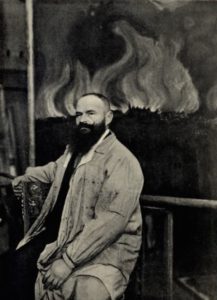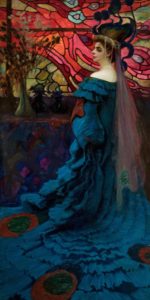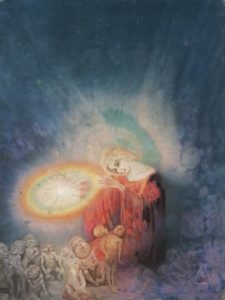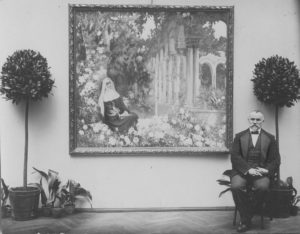KAZIMIERZ STABROWSKI TIMELINE
1869 (November 29): Kazimierz Stabrowski was born in Kruplany (Russian Empire, formerly Poland, present-day Belarus).
1887: Stabrowski was admitted to the Academy of Fine Arts in St. Petersburg.
1892: While preparing for his diploma in painting, Stabrowski travelled for a few months to Greece and the Middle East.
1894: Stabrowski travelled to Germany. He completed the painting Mohammed in the Desert, also known as Escape from Mecca, for which he was awarded the Great Gold Medal by the St. Petersburg Academy of Fine Arts. He started studying under I.J. Riepin.
1897: Stabrowski went to Paris, where he studied painting in the Académie Julian under J.-J. Benjamin-Constant and J.-P. Laurens.
1890: Stabrowski returned to St. Petersburg.
c. 1900: Stabrowski wrote his short story, Legend.
1902 (September 15): Stabrowski married Julia Janiszewska. They moved to Warsaw, where the painter joined the Polish Artists’ Society “Art” [Sztuka] and started preparing for establishing a School of Fine Arts.
1904 (March 17): The Warsaw School of Fine Arts was established. Stabrowski became its director and one of its professors. In the same year, Lithuanian painter Mikalojus Konstantinas Čiurlionis joined the Academy. The show Lilla Weneda, with Stabrowski’s scenography, debuted at The City Theater in Kraków.
1905: Stabrowski became a member of the Theosophical circle in Warsaw that later evolved into the “Alba” lodge, of which he became the Secretary.
1908: “The Young Art” ball took place (organized annually since then) and became a source of inspiration for a series of esoterically inspired paintings by Stabrowski, including In Front of Stained Glass – A Peacock , The Princess of the Magic Crystal, and The Story of the Waves.
1909: Stabrowski was involved in a conflict with one of the School committee members, because both of financial problems of the institution and his involvement in the occult. As a consequence, he resigned from his position as director. Roughly at the same time, he became one of the founding members of the Warsaw Theosophical Society. Around this time, he also painted Vision I–III (Sketches for Annunciation).
1912: The Warsaw Theosophical Society, of which Stabrowski was the head, was registered in April.
1913: Stabrowski took part in the European Theosophical Conference in Stockholm, where he also exhibited his paintings. After the Conference, he went to Berlin and left his works in care of the family of Rudolph Steiner, so that the founder of the Anthroposophical Society and German artists could see them.
1915: During World War I, Stabrowski moved to St. Petersburg. He organized a large exhibition of his works there.
1916: Stabrowski collaborated in several artistic events held in Moscow.
1918: Stabrowski and his wife moved back again to Warsaw, due to the political situation in Russia. He established the artistic association “Sursum Corda” and organized an important exhibition in Warsaw.
1920: Stabrowski took part in organizing the Polish Theosophical Society. In this year, he painted The Consoler of Monsters and Angel and Monsters.
1924: Stabrowski became a member of a Polish Anthroposophical group that started to form in this time (the Polish Anthroposophical Society would be established officially only in the year the painter died). He painted Fantastic Composition.
1927: Stabrowski celebrated a jubilee for his 40 years of artistic work. Four exhibitions celebrated the event.
1929 (June 8): Stabrowski died in Garwolin, near Warsaw, Poland.
BIOGRAPHY
Kazimierz Stabrowski was a celebrated Polish painter, and the founder and first  director of the Academy of Fine Arts in Warsaw. [Image at right] He was also a very important figure in the Polish esoteric milieu: he was the first secretary of a registered Theosophical group in Poland, a founding member of the Polish Theosophical Society, and later a co-founder of the Anthroposophical Society in Poland in the 1920s. His esoteric interests reflect in some of his paintings. He is well-known as an artist for his dreamy landscapes, but even more for his symbolic, fantastic, and mystical compositions.
director of the Academy of Fine Arts in Warsaw. [Image at right] He was also a very important figure in the Polish esoteric milieu: he was the first secretary of a registered Theosophical group in Poland, a founding member of the Polish Theosophical Society, and later a co-founder of the Anthroposophical Society in Poland in the 1920s. His esoteric interests reflect in some of his paintings. He is well-known as an artist for his dreamy landscapes, but even more for his symbolic, fantastic, and mystical compositions.
Stabrowski was born on November 29, 1869 in Kruplany, a village near Nowogródek that was then in the Russian Empire, although it was earlier part of Poland and is located in present-day Belarus. Stabrowski’s parents Antoni and Zofia (née Pilecka) belonged to a family of Polish landed gentry. Stabrowski’s early education took place in the Real School in Białystok, which he attended from 1880 to 1886. In 1887, he was admitted to the Academy of Fine Arts in St. Petersburg (Skalska-Miecik 2002:275).
During his studies in the Academy, he travelled to several countries to improve his working skills. In 1892, he went via Odessa, Constantinople, Athens, Rhodes, Smyrna, Beirut, and Jaffa to Palestine (Jerusalem), where he took part in a Catholic retreat and received his confirmation, before traveling further to Port Said, Alexandria, and Cairo. Two years later, he went to Germany and spent a few months there. He was regarded as a very talented student, who won several prizes in St. Petersburg for his painting: a Small and a Great Silver Medals in 1892, another Great Silver Medal in 1893, and a Great Golden Medal in 1894, when he received his diploma. He obtained a Master’s Degree with a painting entitled Mohammed in the Desert (known also as Escape from Mecca). In this work his religious and metaphysical interests, which would shape his later career, were already present.
His life-long passion for travels supplied him with inspiration and fueled his interest in the mystic East. From the time of his early art studies, he was also interested in Theosophy, that he had encountered in the esoteric milieus of St. Petersburg. After getting his diploma, Stabrowski studied one year in the workshop of renowned Russian realist painter Ilja Repin (1844–1930), under whose influence he remained for a long time.
In 1897, Stabrowski went to Paris to continue his studies in painting at the famous Académie Julian. His main teachers there were Jean-Joseph Benjamin-Constant (1845-1903), a French painter well-known for his Orientalist taste, and the academic painter and sculptor Jean-Paul Laurens (1838-1921). After one year, he came back to St. Petersburg. In this time, besides painting, Stabrowski started to make a name for himself as an art critic and writer. He published several art-related notes and essays in Russian newspapers, and also wrote (but did not publish) a short story, Legend (Stabrowski c.1895-1905).
Some Polish art historians (e.g. Skalska 2002:275) claimed that, after Stabrowski left Riepin’s workshop and went to Paris, he spent a year in Munich where he studied under the Greek painter Nikolaos Gyzis (1842-1901). If confirmed, the detail would be relevant, as Gyzis was himself deeply interested in mysticism and esotericism. However, based on our own research, documents at the Academy of the Fine Arts in Munich show that, at that time, a Polish student named Stabrowski did study under Gyzis, but his first name was Edmond, not Kazimierz, he was born in Warsaw and was twenty, while our Stabrowski was born in Kruplany and was twenty-six.
In 1902, Stabrowski married Julia Janiszewska (1869-1941), herself an artist, who had completed her studies in sculpture at the Academy of Fine Arts in St. Petersburg. After the marriage, they moved to Warsaw, where the painter became a member of the Polish Artists’ Society “Sztuka” (Art). He started to organize an artistic academy thanks to the support of his Russian connections, including the Grand Duke Sergei Alexandrovich (1857–1905). With the permission of the Governor General, the Warsaw School of Fine Arts was officially opened on March 17, 1904. It is the ancestor of present-day Academy of Fine Arts in Warsaw. Stabrowski became its first director, and one of the first teachers, along with such well-known Polish artists as Xavery Dunikowski (1875–1964), Ferdynand Ruszczyc (1870–1936), Konrad Krzyżanowski (1872–1922), and Karol Tichy (1871–1939).
In this time, Stabrowski’s esoteric interests also flourished. He became a member of the first Polish Theosophical circle. Later, this informal circle became the Alba Lodge, placed under the jurisdiction of the Russian Theosophical Society and named after the leading Russian Theosophist, Anna “Alba” Kamenskaya (1867–1952 ). Stabrowski became its Secretary. We do not know exactly at what date Stabrowski first joined the Theosophical Society. We do know, however, that he was officially a member of the Theosophical Society in England in the first years of the twentieth century and that, after the Russian branch of the Theosophical Society was officially established in 1908 (incorporated on September 30 and registered on November 17), he was transferred to the Russian Section on December 18, 1908.
In 1904, Stabrowski’s Warsaw School of Fine Arts enrolled as a student Mikalojus Konstantinas Čiurlionis (1875–1911), a Lithuanian composer, who later also gained international fame as a painter. Čiurlionis was twenty-nine at this time, which made him one of the School’s oldest students, and he befriended some of his teachers (Žukienė 2015:12). At the time of his studies and friendship with Stabrowski, the Lithuanian artist also developed his interests in Theosophy (Hess and Dulska 2017). Although Čiurlionis died young (at age thirty-six), and never joined the Theosophical Society, a number of allusions to Theosophy are recognizable in his works (Introvigne 2013).
Stabrowski was active in the esoteric milieu in Warsaw, which included well-known writers, painters, and other members of the cultural elite of the time. He organized the so called “wild strawberry tea” meetings, where occult phenomena as well as Theosophical and Kabbalistic ideas were debated (Mažrimienė 2015:45-46). Spiritualist séances were also held there. They were attended by such prominent figures as the Polish poet and playwright Tadeusz Miciński (1873–1918) and the above mentioned Čiurlionis, who sometimes also played the role of a medium (Hass 1984:90), Zenon Przesmycki (1861–1944), the editor of the journal Chimera, Artur Górski (1870–1959), whose series of articles titled “Young Poland” gave the name to an important current in Polish visual arts, Bolesław Leśmian (1877–1937), a renowned poet, and others (Siedlecka 1996:63). Stabrowski was also a regular guest at similar meetings that were held in the home of poet Edward Słoński (1872–1926) and featured the famous Polish Spiritualist medium, Jan Guzik (1875-1928).
Polish artists interested in Theosophy also cooperated in various ventures. Stabrowski prepared Theosophically-inspired covers and illustrations for books written by other Polish members of the Theosophical Society, such as Tadeusz Miciński’s Nietota: The Book of Tatra Mystery and the works of Hanna Krzemieniecka (pen name of Janina Furs-Żyrkiewicz, 1866-1930), Fate and And when He Leaves into the Eternal Abyss… A Romance beyond the Grave. The Theosophical circle of Stabrowski in the first decade of the twentieth century seems to have been strongly influenced by Rudolf Steiner (1861-1925), the leader of the German branch of the Theosophical Society who later founded Anthroposophy. Like Steiner, Stabrowski and his friends emphasized both Theosophical Eastern ideas and the esoteric dimensions of Christianity.
In 1908, the Warsaw Philharmonic hosted a memorable “Young Art” ball, organized by the Warsaw School of Fine Arts (Sieradzka 1980:187). The Academy held numerous artistic events, but the balls became an annual tradition of the school for many years, as documented by Stabrowski’s portraits of several participants in these events. These paintings, however, are not just portraits, but fantastic and symbolic interpretations of female beauty, inspired by Theosophical thought. Among them were In Front of Stained Glass – A Peacock, [Image at right] The Princess of the Magic Crystal, and The Story of the Waves.
organized by the Warsaw School of Fine Arts (Sieradzka 1980:187). The Academy held numerous artistic events, but the balls became an annual tradition of the school for many years, as documented by Stabrowski’s portraits of several participants in these events. These paintings, however, are not just portraits, but fantastic and symbolic interpretations of female beauty, inspired by Theosophical thought. Among them were In Front of Stained Glass – A Peacock, [Image at right] The Princess of the Magic Crystal, and The Story of the Waves.
The career of Stabrowski as director of the Warsaw School of Fine Arts came to an end in 1909, when he resigned after having been involved in a conflict with one of the school committee members. He was accused of poor management (because of financial problems of the Academy), but also criticized for his involvement in the occult and for having invited students to Spiritualist séances. Stabrowski wrote a response to the accusations, but resigned anyway.
The Polish members of the Theosophical Society were very keen on having their own branch, one that would not be directly connected to the Russian Theosophical Society. It was a political statement, implicitly criticizing Russian occupation of Poland. A letter survives, which Stabrowski sent in 1910 to the Theosophical Society’s headquarters in Adyar seeking an independent status for the Polish branch (Stabrowski 1910), but his efforts were initially unsuccessful. Only in April 1912, the Alba lodge was reconstituted as separated from the Russian section, and registered as the Warsaw Theosophical Society, with its statutes ratified by the Governor General (Bocheński n.d.; Karas 1958).
In 1913, Stabrowski took part in the European Conference of the National Sections of the Theosophical Society held in Stockholm, where he also exhibited his paintings. After the conference, he went to Berlin and left most of his works exhibited in Stockholm in care of the family of Rudolph Steiner (Skalska-Miecik 2002:276). Kalinowski claims that Stabrowski was on his way to Italy via Berlin when he met Steiner, and was asked by him to leave the paintings in Germany so that, after the Theosophists in Stockholm, artists in Berlin might see them too. Unfortunately, after Steiner’s death, those paintings were lost (Kalinowski 1927:7). Some other works, which revealed Stabrowski’s esoteric interests, but of which only the titles remain, were: Radiant [Promienisty], Larvae [Larwy], On the edge of the invisible [Na granicy niewidzialnego], In the Astral [W astralu], and others (Makowska 1986:332). Alojzy Gleic claimed that Stabrowski later also became interested in Rosicrucianism, astrology, and Kabbalah (Glejc 1936:75).
During World War I, in 1915, Stabrowski and his wife moved to St. Petersburg. He organized a large exhibition of his works there and travelled to several countries. He also took part in the Russian cultural life, not only in St. Petersburg but also in Moscow. After three years, the Stabrowskis moved back to Warsaw, due to the political situation prevailing in Russia. At this time, many of his paintings were damaged or lost. When in Poland, his interest in mysticism led Stabrowski to establish an ephemeral group, “Sursum Corda,” in 1922 (Morawińska 1997:210)
He organized a large exhibition of his works there and travelled to several countries. He also took part in the Russian cultural life, not only in St. Petersburg but also in Moscow. After three years, the Stabrowskis moved back to Warsaw, due to the political situation prevailing in Russia. At this time, many of his paintings were damaged or lost. When in Poland, his interest in mysticism led Stabrowski to establish an ephemeral group, “Sursum Corda,” in 1922 (Morawińska 1997:210)
In 1920, now in independent Poland, Stabrowski took part in the forming of the Polish Theosophical Society (Skalska-Miecik 2002:276). The organization was registered legally in the country in 1921, and became an official national section of the Theosophical Society, Adyar in 1923, with Wanda Dynowska (1888–1971) as its Secretary General (Hess 2015:65-66). In this period, Stabrowski painted The Consoler of Monsters, [Image at right] Angel and Monsters, and Fantastic Composition. Those paintings are also considered as inspired by Theosophy (Hess and Dulska 2017).
Since Stabrowski had always been an admirer of Rudolph Steiner, both during the latter’s career in the Theosophical Society and thereafter, it is not surprising that in 1924 the painter became a member of a Polish Anthroposophical group that started to form in this time. However, the Polish Anthroposophical Society was established officially only in the year of Stabrowski’s death.
In his last years, Stabrowski was recognized as one of Poland’s leading  painters, and continued his travels to a number of countries. In 1927, he celebrated his jubilee for forty years of artistic work. On the occasion, four exhibitions were organized: in Poznań, Łódź, Bydgoszcz, and Warsaw. [Image at right] Stabrowski died in Garwolin near Warsaw, on June 8, 1929, at age sixty. According to his family, his death occurred in somewhat mysterious circumstances (Skalska-Miecik 2002:277). He is regarded as a leading exponent of Polish symbolism, although the category of symbolism in general is now increasingly controversial and has been deconstructed by some critics. The important influence of Theosophy and, later, Anthroposophy in his work is increasingly recognized by historians, and Stabrowski also played a crucial role in introducing other artists and poets to Theosophical ideas.
painters, and continued his travels to a number of countries. In 1927, he celebrated his jubilee for forty years of artistic work. On the occasion, four exhibitions were organized: in Poznań, Łódź, Bydgoszcz, and Warsaw. [Image at right] Stabrowski died in Garwolin near Warsaw, on June 8, 1929, at age sixty. According to his family, his death occurred in somewhat mysterious circumstances (Skalska-Miecik 2002:277). He is regarded as a leading exponent of Polish symbolism, although the category of symbolism in general is now increasingly controversial and has been deconstructed by some critics. The important influence of Theosophy and, later, Anthroposophy in his work is increasingly recognized by historians, and Stabrowski also played a crucial role in introducing other artists and poets to Theosophical ideas.
IMAGES**
**All images are clickable links to enlarged representations.
Image #1: Portrait of Kazimier Strabrowski.
Image #2: Stabrowski painting: In Front of Stained Glass.
Image #3: Stabrowski painting: The Consoler of Monsters.
Image #4: Strabrowsk in 1927 at the exhibition in Poznan.
REFERENCES
Bocheński, Władysław. n.d. Moje wspomnienia z okresu należenia do Polskiego Towarzystwa Teozoficznego w latach 1922–1939 . Archival document from Archiwum Nauki PAN i PAU w Krakowie. Kazimierz Tokarski 1930–2007, KIII-180: 16 and 20.
Glejc, Alojzy Krzysztof. 1939. Glossariusz okultyzmu. Kraków: Wydawnictwo Wawelskie.
Hass, Ludwik. 1984. Ambicje, rachuby, rzeczywistość. Wolnomularstwo w Europie Środkowo-Wschodniej 1905-1928. Warsaw: Państwowe Wydawnictwo Naukowe.
Hess, Karolina Maria. 2015. “The Beginnings of Theosophy in Poland: From Early Visions to the Polish Theosophical Society.” Pp. 53–71 in The Polish Journal of the Arts and Culture, no. 13.
Hess, Karolina Maria and Małgorzata Alicja Dulska. 2017. “Kazimierz Stabrowski’s Esoteric Dimensions: Theosophy, Art, and the Vision of Femininity.” La Rosa di Paracelso, issue The Eternal Esoteric Feminine [forthcoming].
Introvigne, Massimo. 2013. Čiurlionis’ Theosophy: Myth or Reality? Paper presented at the conference Enchanted Modernities: Theosophy and the Arts in the Modern World, Amsterdam, September 26, 2013.
Kalinowski, Kazimierz . 1927. K. Stabrowski. Sylwetka malarza-poety. Poznań: Wielkopolski Związek Artystów Plastyków.
Karas, Evelyn. 1958. The Theosophical Society and Theosophy in Poland . A talk given at the School of Wisdom, Aydar, March 1958. Archival document from Archiwum Nauki PAN i PAU w Krakowie, Kazimierz Tokarski 1930–2007, KIII-180: 20.
Lilla Weneda. 1904. Poster, 23 May 1904. Kraków: Dyrekcja Teatru Miejskiego.
Makowska, Urszula. 1986. “Wiedza tajemna Wschodu. Tendencje okultystyczne w kulturze polskiej na przełomie XIX i XX wieku.” Pp 323–38 in Orient i orientalizm w sztuce . Materiały Sesji Stowarzyszenia Historyków Sztuki, Kraków, grudzień 1983. Warsaw: Polskie Wydawnictwo Naukowe.
Morawińska, Agnieszka. 1997. Symbolizm w malarstwie polskim 1890-1914. Warsaw: Arkady.
Piwocki, Ksawery. 1965. Historia Akademii Sztuk Pięknych w Warszawie 1904-1964. Wrocław: Zakład Narodowy im. Ossolińskich.
Siedlecka, Jadwiga. 1996. Mikołaj Konstatnty Ciurlionis 1875-1911. Preludium warszawskie. Warsaw: AgArt.
Sieradzka, Anna. 1980. “’Bal Młodej Sztuki’ w 1908 roku i jego reminiscencje plastyczne i literackie.” Pp. 187–98 in Biuletyn Historii Sztuki , no. 42.
Skalska, Lija. 1975. “Kazimierz Stabrowski – lata studiów i początki działalności twórczej.” Pp. 575–657 in Rocznik Muzeum Narodowego w Warszawie, vol.. 19.
Skalska-Miecik, Lija. 1984. “Echa sztuki rosyjsiej w twórczości warszawskich modernistów.” Pp. 125–72 in Rocznik Muzeum Narodowego w Warszawie, no. 28.
Skalska-Miecik, Lija. 2002. “Kazimierz Stabrowski.” Pp. 275–78 in Polski Słownik Biograficzny, vol. 41.
Stabrowski, Kazimierz. 1910. Letter. Archival material in Archiwum Nauki PAN i PAU w Krakowie, Kazimierz Tokarski 1930-2007, KIII-180:19.
Stabrowski Kazimierz. c.1895-1905. Legenda [unpublished]. Manuscript in the Biblioteka Narodowa. Warsaw.
Žukienė, Rasa. 2015. “Shades of Lithuania in the work of Mikalojus Konstantinas Čiurlionis.” Pp. 8–35 in M. K. Čiurlionis. Litewska opowieść. Krakow: International Cultural Centre, and Kaunas: M.K. Čiurlionis National Museum of Art.
Post Date:
9 February 2017
